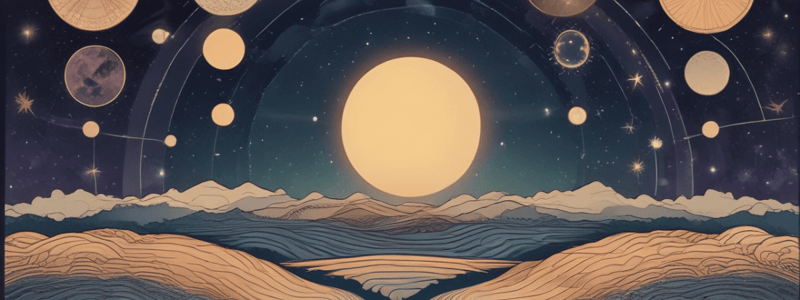Podcast
Questions and Answers
Explain the concept of celestial bodies Earth, sun, and moon.
Explain the concept of celestial bodies Earth, sun, and moon.
Celestial bodies refer to natural objects in the sky, such as the Earth, sun, and moon, which play a significant role in astronomical phenomena.
What causes the different phases of the moon and their cyclic patterns?
What causes the different phases of the moon and their cyclic patterns?
The varying positions of the moon in relation to the Earth and sun cause the different phases of the moon and their cyclic patterns.
How do solar and lunar eclipses differ?
How do solar and lunar eclipses differ?
Solar eclipses occur when the moon passes between the Earth and the sun, blocking sunlight, while lunar eclipses occur when the Earth passes between the sun and the moon, casting a shadow on the moon.
What is the role of the Earth's axis tilt in causing seasons?
What is the role of the Earth's axis tilt in causing seasons?
Explain the gravitational forces exerted by the moon and sun on Earth's oceans.
Explain the gravitational forces exerted by the moon and sun on Earth's oceans.
How do celestial cycles influence natural phenomena like plant growth and climate patterns?
How do celestial cycles influence natural phenomena like plant growth and climate patterns?
Why did ancient civilizations use celestial observations for navigation, agriculture, and timekeeping?
Why did ancient civilizations use celestial observations for navigation, agriculture, and timekeeping?
How does the Earth's position relative to the sun change during different seasons?
How does the Earth's position relative to the sun change during different seasons?
During which week are students introduced to the concept of Earth's tilt affecting seasons?
During which week are students introduced to the concept of Earth's tilt affecting seasons?
What celestial events are being explored in Week 4 of the curriculum?
What celestial events are being explored in Week 4 of the curriculum?
What is the main focus of Week 5 in the curriculum?
What is the main focus of Week 5 in the curriculum?
When does a neap tide occur during the lunar month?
When does a neap tide occur during the lunar month?
Which celestial bodies are involved in generating tides on Earth?
Which celestial bodies are involved in generating tides on Earth?
What is the main difference between solar and lunar eclipses?
What is the main difference between solar and lunar eclipses?
What phenomenon directly results from the tilt of Earth's axis?
What phenomenon directly results from the tilt of Earth's axis?
Which aspect is NOT covered in Week 2 of the curriculum?
Which aspect is NOT covered in Week 2 of the curriculum?
Flashcards are hidden until you start studying




